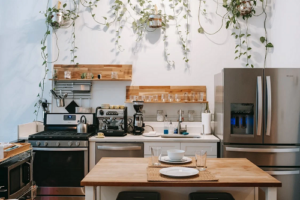How to Grow and Care for Fiddle Leaf Fig

The Fiddle Leaf Fig, with its glossy, broad leaves and sculptural presence, has become one of the most sought-after houseplants in recent years. Its dramatic foliage not only adds a touch of the tropics to interiors but also purifies the air, making it both beautiful and functional. If you’re considering adding a Fiddle Leaf Fig to your indoor plant collection or already own one and want to ensure its optimal health, this guide is for you.
Also Read:- From Kitchen to Garden: Comprehensive Guide to Fruit Fly Traps
Is Fiddle Leaf Fig a Good Indoor Plant?
Absolutely! The Fiddle Leaf Fig (Ficus lyrata) is native to the lowland tropical rainforests of western Africa, but it has adapted remarkably well to indoor environments. Its large, violin-shaped leaves make it a statement piece in any room, and its ability to thrive in indirect light makes it a favorite among indoor gardeners.
Do Fiddle Leaf Figs Need Sun?
Fiddle Leaf Figs prefer bright, indirect sunlight. While they can tolerate some direct sunlight, prolonged exposure can cause their leaves to burn. A north or east-facing window is ideal. If you notice the plant’s leaves reaching or leaning towards the light, it’s a sign that it might need a bit more sunlight.
Why Are Fiddle Leaf Figs So Expensive?
Several factors contribute to the cost of Fiddle Leaf Figs:
- Popularity: Their surge in popularity, thanks to interior design magazines and social media, has increased demand.
- Growth Rate: They’re relatively slow growers, which means nurseries need to invest a longer time in care before they’re ready for sale.
- Size: Larger, more mature plants command higher prices due to their impressive stature and the time taken to reach that size.
Caring for Your Fiddle Leaf Fig
- Watering: Water when the top inch of soil is dry. Overwatering can lead to root rot, a common issue with this plant.
- Soil: Use a well-draining potting mix. Consider a mix designed for cacti or succulents, which ensures good drainage.
- Humidity: While they can tolerate average humidity, they’ll thrive in higher humidity environments. Consider misting the leaves or using a humidifier.
- Feeding: During the growing season (spring and summer), feed with a diluted general-purpose liquid fertilizer every month.
Addressing Common Concerns
- Brown Spots: This can be a sign of overwatering or a fungal infection. Ensure you’re not letting the plant sit in water and consider repotting if the soil feels overly damp.
- Dropping Leaves: A sudden change in temperature, light, or transplant shock can cause leaf drop. Ensure the plant is in a stable environment and avoid frequent relocations.
Fiddle Leaf Fig Varieties
While the classic Fiddle Leaf Fig tree is the most popular, there are other varieties:
- Fiddle Leaf Fig Bush: This is a bushier version, with more leaves and a shorter stature.
- Bambino: A dwarf variety with smaller leaves, perfect for smaller spaces.
Where to Buy a Fiddle Leaf Fig
Many local nurseries and online plant shops offer Fiddle Leaf Figs for sale. Prices vary based on size and maturity. Always choose a reputable seller to ensure you’re getting a healthy specimen.
Conclusion
The Fiddle Leaf Fig, with its iconic foliage and statuesque presence, can be a stunning addition to any indoor space. With the right care, it can thrive and grow, becoming a focal point in your home. Whether you’re a seasoned plant parent or a newbie, this guide provides all the knowledge you need to nurture and enjoy this tropical beauty.








